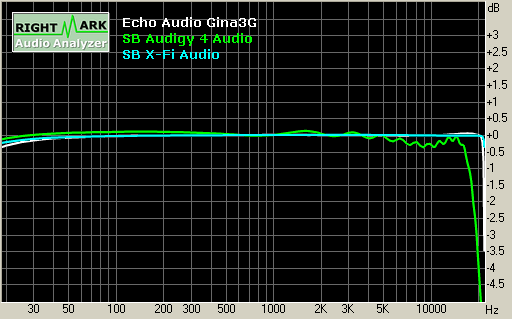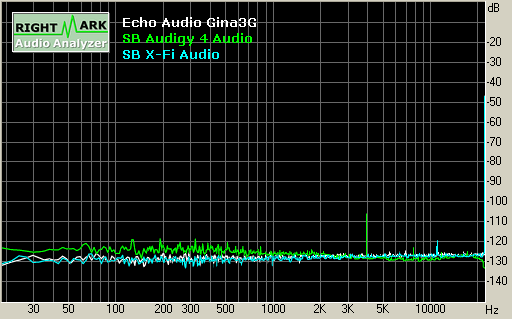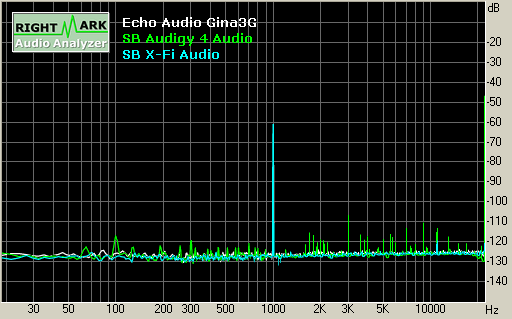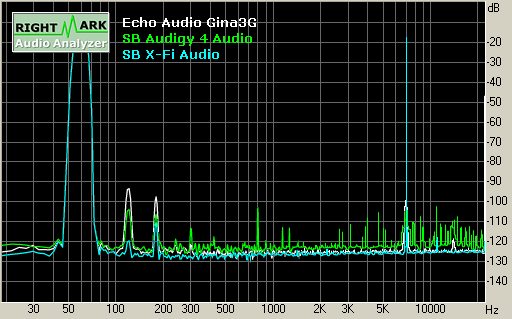X-Fi and the Elite Pro: SoundBlaster's Return to Greatness
by Derek Wilson on August 30, 2005 11:59 AM EST- Posted in
- Smartphones
- Mobile
Quantitative Analysis: RMAA 16-bit / 44.1 kHz
RightMark Audio Analyzer is the best tool that we have right now for determining solid numbers that describe the precision and capabilities of sound hardware in our labs. We are able to measure many of the interesting electrical characteristics of the hardware by running RMAA, which captures the output of a sound card playing a test file and analyses the recording. Unfortunately, the electrical characteristics of the recording hardware come into play when using RightMark. By using quality recording equipment, we can still get a very good idea of the hardware's capabilities. For a more in-depth look at what we are looking for in our RMAA tests, check out this page on our electrical analysis of sound hardware.The best way to see what's going on is to dive into the numbers.
| Test | Echo Audio Gina3G | SB Audigy 4 Audio | SB X-Fi Audio |
| Frequency response (from 40 Hz to 15 kHz), dB: | +0.04, -0.09 | +0.13, -0.36 | +0.01, -0.07 |
| Noise level, dB (A): | -94.3 | -94.5 | -94.7 |
| Dynamic range, dB (A): | 94.1 | 94.1 | 94.6 |
| THD, %: | 0.0057 | 0.0033 | 0.0008 |
| IMD + Noise, %: | 0.0079 | 0.0081 | 0.0054 |
| Stereo crosstalk, dB: | -94.9 | -93.3 | -97.0 |
Frequency response of the X-Fi is much better at 16-bit 44.1 kHz than the Audigy. In fact, we can see that the frequency response curve is even flatter than the Gina 3G here. The SoundBlaster X-Fi Elite Pro posts better numbers any card we've yet tested in our labs at this very heavily used bitrate.
When looking at the graphs, note that the X-Fi is able to post these numbers while maintaining consistant performance in each test. The only tradeoff we see is in stereo cross-talk, which just shows a trade off at high frequencies rather than low.

Frequency Response

Noise Level

Dynamic Range

THD+N at -3dB FS

Intermodulation Distortion

Stereo Crosstalk










110 Comments
View All Comments
DerekWilson - Wednesday, August 31, 2005 - link
That's not a game port, its a digital connector to the break out box. The breakout box has optical in and out, spdif out, RCA out, quarter inch out, and problabaly a few things I'm forgetting right now.There is no daughter card connection. The thing that looks like it is a dell case front panel connector. For whatever reason.
Saist - Tuesday, August 30, 2005 - link
I'm trying hard not to be the wet blanket, but why in the world is everyone so gung-ho about creative products? I know I'm not the only one whose suffered from scratchy sound, static generation, swapped speaker channels, and dropped speaker channels with Creative cards. I've lost count of the number of games I've played where a sound issue has been specifically traced to a Creative driver set or Creative hardware problem. I don't want to even think about leaving the "well supported" windows world and looking towards systems that use ALSA, ARTS, or OSS sound systems. The lack of documentation makes setting up and running creative cards a pain in the rear.Quite frankly, given what I've seen of Creative's products and experienced, I'll stick with my Via Envy and wait for Via Envy2 if I'm going to upgrade. Just doesn't seem to be any sense to stick to Creative's path which invariably either winds up with less than desirable products and higher than desirable prices.
flexy - Tuesday, August 30, 2005 - link
i take 10 ! :)
a) any REAL pro will probably NOT get a creative soundcard
b) a gamer/casual PC enthusiast will probably NOT spend $400 on a soundcard.
c) i had to stop reading the article and laughed when i read "$400"...and i laughed even more when i read that " Unfortunately, there are not a great many games out there that support X-Fi yet. On our list are Doom 3 and Battlefield 2. We tested both of these games and attained good results. We weren't able to create accurate and repeatable sound tests, but from our subjective analysis of gameplay, we couldn't really discern a quality difference between older hardware and the X-Fi."
in other words: You did NOT see (hear) any difference between a Audigy 2 and this card - besides the sad fact that there's barely a game out which supports X-FI.
What (please ?) is the point of this card/review ? Makeing us PC enhusiasts want to spend $400 on a soundcard which has no real-life use at all - or convince the *real* audio-professionals that now Creative is a contender in the "pro-market" ?
DerekWilson - Wednesday, August 31, 2005 - link
Creative is a contender and active member in the pro market with their EMU line.I wouldn't use a consumer product for professional applications. I also woulnd't use a pro card for gaming.
I don't recommend the Elite Pro at the $400 price point. But to people who want a gaming card with excellent sound quality and lots of recording features (and have money to burn), the Elite Pro fits their needs.
to be clear, games that support EAX do support the X-Fi ... just not X-RAM -- the defining performance feature. It would be more accurate to say that no game exploits all the features of X-Fi.
JNo - Wednesday, August 31, 2005 - link
Unfortunately Derek, you failed to make it VERY clear that the bottom of the range x-fi card (which most gamers would probably be happy with) is $130, which is very much more in people's spending range for an everyday soundcard. Obviously you didn't get to test it, having the elite pro instead, but because the basic model is very similar with only very slightly worse DACs (only audiophiles can tell), no extra RAM (no/v little impact today), no remote or break out box, some intelligent guesses could have been made as to its value.AnnihilatorX - Tuesday, August 30, 2005 - link
"The SoundBlaster X-Fi Elite Pro is the best non-pro sound solution for audio listening, features and recording"Ironic isn't it lol
PenGun - Tuesday, August 30, 2005 - link
What's the deal with the 1 K spikes in Dynamic Range and THD? The Gina at least is smooth. The creative stuff is all over. You should be aware graphs are useful but are not a good indicator of how a card sounds.PenGun
SDA - Tuesday, August 30, 2005 - link
"The SoundBlaster X-Fi Elite Pro is the best non-pro sound solution for audio listening, features and recording. "That's like saying that a Prescott is the best non-low-wattage, non-AMD solution for games. Yes, whoopee, but what if you don't have stupid limitations?
To make myself clearer: a pro sound solution at the same price point or below would offer better sound quality, more features, and better recording capability.
Googer - Wednesday, August 31, 2005 - link
I Love the irony of this statement.
Eskimooo - Tuesday, August 30, 2005 - link
Wherever I search web before spending any larger sum there are always people complaining about the stuff they have never seen an/or have no clue about.Why do you post opinion like that and give no example? What is the point?
I mean I am reading reviews and I am trying to make a well informed decision about how to spend my money. If you draw a comparison, do it really, so that it is a valid point.
So what is the soundcard that would give me better quality of sound at recording, playback and more features at the same time at the same price?
I did not have opportunity to listen to music played back with system using X-Fi so I am looking for opinions from those who did before I eventually decide to order it online, too. Thanks to Derek this review. I have read about X-Fi enough to believe it is worth the price and that it will serve me well for a good few years like the Live card did.
Enlighten me, cus I am looking better feature set